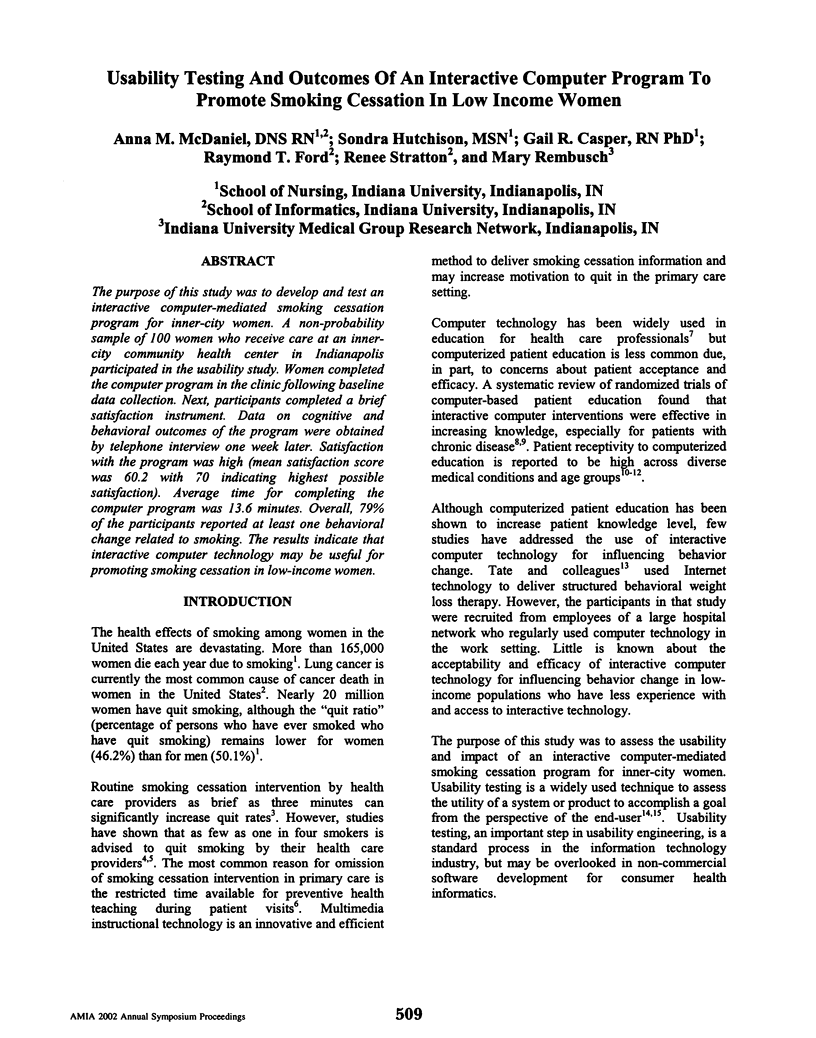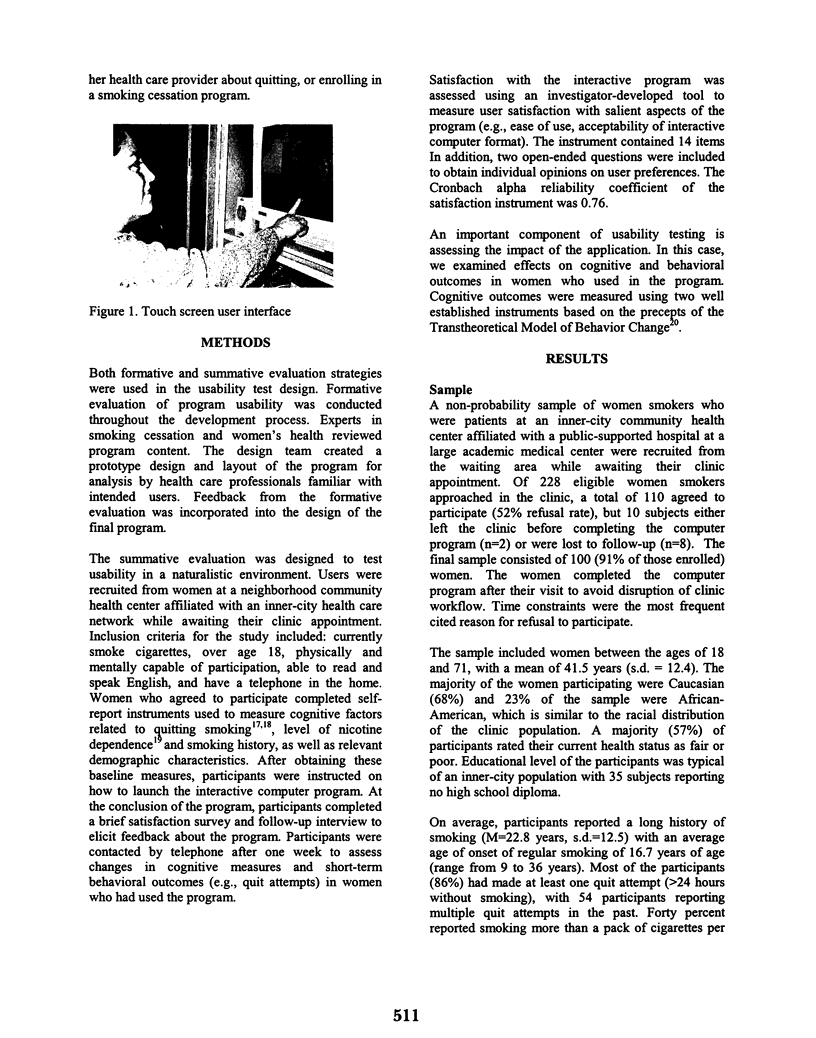Abstract
The purpose of this study was to develop and test an interactive computer-mediated smoking cessation program for inner-city women. A non-probability sample of 100 women who receive care at an inner-city community health center in Indianapolis participated in the usability study. Women completed the computer program in the clinic following baseline data collection. Next, participants completed a brief satisfaction instrument. Data on cognitive and behavioral outcomes of the program were obtained by telephone interview one week later. Satisfaction with the program was high (mean satisfaction score was 60.2 with 70 indicating highest possible satisfaction). Average time for completing the computer program was 13.6 minutes. Overall, 79% of the participants reported at least one behavioral change related to smoking. The results indicate that interactive computer technology may be useful for promoting smoking cessation in low-income women.
Full text
PDF




Images in this article
Selected References
These references are in PubMed. This may not be the complete list of references from this article.
- Brown S. J., Lieberman D. A., Germeny B. A., Fan Y. C., Wilson D. M., Pasta D. J. Educational video game for juvenile diabetes: results of a controlled trial. Med Inform (Lond) 1997 Jan-Mar;22(1):77–89. doi: 10.3109/14639239709089835. [DOI] [PubMed] [Google Scholar]
- DiClemente C. C., Prochaska J. O., Fairhurst S. K., Velicer W. F., Velasquez M. M., Rossi J. S. The process of smoking cessation: an analysis of precontemplation, contemplation, and preparation stages of change. J Consult Clin Psychol. 1991 Apr;59(2):295–304. doi: 10.1037//0022-006x.59.2.295. [DOI] [PubMed] [Google Scholar]
- Douglas T. S., Mann N. H., Hodge A. L. Evaluation of preoperative patient education and computer-assisted patient instruction. J Spinal Disord. 1998 Feb;11(1):29–35. [PubMed] [Google Scholar]
- Heatherton T. F., Kozlowski L. T., Frecker R. C., Fagerström K. O. The Fagerström Test for Nicotine Dependence: a revision of the Fagerström Tolerance Questionnaire. Br J Addict. 1991 Sep;86(9):1119–1127. doi: 10.1111/j.1360-0443.1991.tb01879.x. [DOI] [PubMed] [Google Scholar]
- Jaén C. R., Crabtree B. F., Zyzanski S. J., Goodwin M. A., Stange K. C. Making time for tobacco cessation counseling. J Fam Pract. 1998 May;46(5):425–428. [PubMed] [Google Scholar]
- Krishna S., Balas E. A., Spencer D. C., Griffin J. Z., Boren S. A. Clinical trials of interactive computerized patient education: implications for family practice. J Fam Pract. 1997 Jul;45(1):25–33. [PubMed] [Google Scholar]
- Lewis D. Computer-based approaches to patient education: a review of the literature. J Am Med Inform Assoc. 1999 Jul-Aug;6(4):272–282. doi: 10.1136/jamia.1999.0060272. [DOI] [PMC free article] [PubMed] [Google Scholar]
- McBride P. E., Plane M. B., Underbakke G., Brown R. L., Solberg L. I. Smoking screening and management in primary care practices. Arch Fam Med. 1997 Mar-Apr;6(2):165–172. doi: 10.1001/archfami.6.2.165. [DOI] [PubMed] [Google Scholar]
- McDaniel A. M., Matlin C., Elmer P. R., Paul K., Monastiere G. Computer use in staff development. A national survey. J Nurses Staff Dev. 1998 May-Jun;14(3):117–126. doi: 10.1097/00124645-199805000-00002. [DOI] [PubMed] [Google Scholar]
- Prochaska J. O., DiClemente C. C. Stages and processes of self-change of smoking: toward an integrative model of change. J Consult Clin Psychol. 1983 Jun;51(3):390–395. doi: 10.1037//0022-006x.51.3.390. [DOI] [PubMed] [Google Scholar]
- Tate D. F., Wing R. R., Winett R. A. Using Internet technology to deliver a behavioral weight loss program. JAMA. 2001 Mar 7;285(9):1172–1177. doi: 10.1001/jama.285.9.1172. [DOI] [PubMed] [Google Scholar]
- Thorndike A. N., Rigotti N. A., Stafford R. S., Singer D. E. National patterns in the treatment of smokers by physicians. JAMA. 1998 Feb 25;279(8):604–608. doi: 10.1001/jama.279.8.604. [DOI] [PubMed] [Google Scholar]
- Velicer W. F., DiClemente C. C., Prochaska J. O., Brandenburg N. Decisional balance measure for assessing and predicting smoking status. J Pers Soc Psychol. 1985 May;48(5):1279–1289. doi: 10.1037//0022-3514.48.5.1279. [DOI] [PubMed] [Google Scholar]
- Wichansky A. M. Usability testing in 2000 and beyond. Ergonomics. 2000 Jul;43(7):998–1006. doi: 10.1080/001401300409170. [DOI] [PubMed] [Google Scholar]



